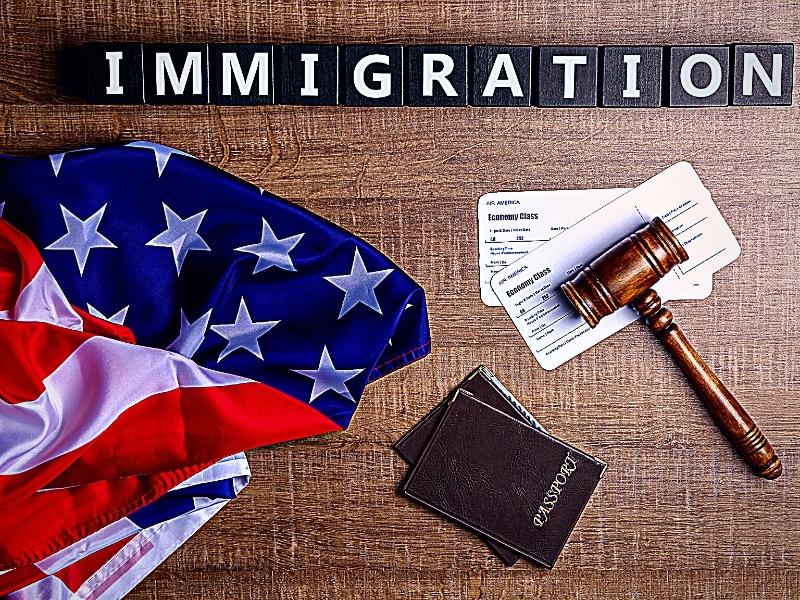The US immigration policy underwent significant changes in 2025, affecting millions of visa applicants, immigrants, and travelers. Whether you’re applying for a work visa, seeking permanent residency, or planning to visit the United States, the policy updates will impact your journey.
This comprehensive guide breaks down all major immigration policy changes in 2025, what they mean for you, and how to navigate the new requirements successfully.
Table of Content

Major US Immigration Policy Changes Overview
1. New Visa Interview Residence Requirements (Effective Immediately)
What Changed:
The U.S. Department of State now requires all nonimmigrant visa applicants to schedule interview appointments at the U.S. embassy or consulate in their country of residence, not just their country of citizenship.
Previous Policy:
- Applicants could interview at any U.S. embassy worldwide
- Common practice: “visa shopping” at embassies with shorter wait times
New Policy (2025):
- Must apply in country where you legally reside
- Consular officers verify residency documentation
- Exceptions require formal approval
Who This Affects:
- International students studying abroad
- Expatriates working in third countries
- Digital nomads without fixed residence
- Diplomatic and military families
- Business travelers with multi-country operations
Example Scenario:
Before: A Chinese citizen working in Singapore could schedule a U.S. tourist visa interview in Thailand (shorter wait time).
Now: The same person must interview at the U.S. embassy in Singapore and provide proof of legal residence in Singapore.
Required Proof of Residency:
- Valid work visa or residence permit
- Long-term rental agreement or property ownership
- Employment letter from local employer
- Utility bills and bank statements
- Tax documents from residence country
Exceptions:
The State Department may grant exceptions for:
- Emergency travel (medical, family death)
- Countries without U.S. embassy/consulate
- Safety and security concerns
- Diplomatic or military assignments
2. Interview Waiver Update (Effective October 1, 2025)
Major Change:
Starting October 1, 2025, the Department of State updated categories of applicants eligible for visa interview waivers.
What is an Interview Waiver?
Certain visa applicants can renew their visas without an in-person interview at a U.S. embassy or consulate.
Previous Waiver Eligibility:
- Same visa category renewal within 12 months of expiration
- Children under 14 and adults over 79
- Diplomatic and official visa holders
- Some repeat business travelers
2025 Updates (Effective October 1):
Expanded Waiver Eligibility:
- Extended renewal window: 48 months (up from 12 months) for certain categories
- New eligible categories: Some first-time applicants in specific visa classes
- Age adjustments: Extended age ranges for automatic waivers
Visa Categories with Extended Waivers:
- B1/B2 (Tourist/Business): 48-month renewal window (was 12 months)
- F1 (Student): Automatic renewal for continuing students
- H1B (Specialty Worker): Same employer renewals eligible
- L1 (Intracompany Transfer): Continuing employment waivers
Restrictions:
Interview waivers NOT available for:
- First-time applicants (with some exceptions)
- Applicants with prior visa denials
- Anyone with criminal records
- Countries designated for enhanced screening
- Visa categories requiring in-person biometrics
How to Apply for Interview Waiver:
1. Check eligibility on embassy website
2. Complete DS-160 application online
3. Pay visa fee
4. Submit documents via designated drop-box location
5. Receive visa by mail (7-14 days processing)
Processing Time:
- Standard: 5-10 business days
- Expedited: 1-3 business days (additional fee, if available)
3. COVID-19 Vaccination Requirement Removed (March 11, 2025)
Major Relief for Immigrants:
The CDC announced removal of the COVID-19 vaccination requirement for immigrant visa applicants effective March 11, 2025.
What This Means:
- No longer need COVID vaccine for green card applications
- Applies to family-based and employment-based immigrants
- Does not affect other required vaccinations
Still Required Vaccinations for Immigration:
- Measles, Mumps, Rubella (MMR)
- Tetanus and Diphtheria
- Pertussis (Whooping Cough)
- Haemophilus influenzae type b (Hib)
- Hepatitis B
- Polio
- Varicella (Chickenpox)
- Influenza (seasonal)
- Pneumococcal disease
Important Distinction:
| Category | COVID Vaccine Required? |
|---|---|
| Immigrant Visas (Green Cards) | No (as of March 2025) |
| Nonimmigrant Visas (Tourist, Work) | No |
| Entry to United States | No |
| International Travel | Varies by airline/destination |
Medical Exam Updates:
- Panel physicians no longer checking COVID vaccination
- Exam still required for all immigrant applicants
- Processing slightly faster without COVID component
4. Employment-Based Visa Limits and Availability
EB-4 (Religious Workers) Category Exhausted
Major Development:
The State Department exhausted all available EB-4 immigrant visas for fiscal year 2025 on February 28, 2025.
What This Means:
- No new EB-4 visas issued until FY 2026 (October 1, 2025)
- Approved applicants must wait for visa availability
- Priority dates retrogressed significantly
Who is Affected:
- Religious workers (ministers, religious professionals)
- Special immigrant juveniles
- Iraqi/Afghan translators
- International organization employees
- Certain medical professionals
Workarounds:
- Apply for nonimmigrant work visa (R-1 for religious workers)
- Wait until FY 2026 visa allocation (October 2025)
- Explore other employment-based categories if eligible
FY 2025 Visa Allocation Numbers
Family-Sponsored Preference: 226,000
- F1 (Unmarried Adult Children of U.S. Citizens): 23,400
- F2A (Spouses/Children of Permanent Residents): 114,200
- F2B (Unmarried Adult Children of Permanent Residents): 26,300
- F3 (Married Children of U.S. Citizens): 23,400
- F4 (Siblings of U.S. Citizens): 65,000
Employment-Based Preference: 150,037
- EB-1 (Priority Workers): 45,011
- EB-2 (Advanced Degree Professionals): 45,011
- EB-3 (Skilled Workers): 45,011
- EB-4 (Special Immigrants): 11,252 (exhausted Feb 2025)
- EB-5 (Investors): 11,252
Read Also; REAL ID 2025: Complete Guide to New Airport Requirements (May 7 Deadline)
5. Visa Bulletin Retrogression
Significant Backlogs Continue:
The 2025 Visa Bulletin shows continued retrogression for many categories and countries.
Countries with Severe Backlogs:
India (Employment-Based):
- EB-1: Current (no wait)
- EB-2: September 2012 (13-year wait!)
- EB-3: February 2012 (13+ year wait)
- EB-4: Unavailable (exhausted)
China (Employment-Based):
- EB-1: Current
- EB-2: March 2019 (6-year wait)
- EB-3: June 2020 (5-year wait)
Mexico (Family-Based):
- F1: August 2000 (25-year wait!)
- F2A: Current
- F2B: February 2000 (25+ year wait)
- F3: June 1999 (26-year wait)
Philippines (Family-Based):
- F1: September 1999 (26-year wait!)
- F2B: June 2002 (23-year wait)
- F3: June 1995 (30-year wait!)
All Other Countries:
- Generally better availability
- Still 2-8 year waits for most categories
- EB-2/EB-3 often current or near-current
What Retrogression Means:
Even with an approved I-140 (employment) or I-130 (family) petition, you cannot apply for a green card until your priority date becomes current.
Visa Processing Times 2025
Current Average Processing Times
Nonimmigrant Visas (Visitor, Work, Student):
- Interview wait time: 2-400+ days (varies by country)
- Processing after interview: 3-14 days
- Administrative processing: 60-180 days (if required)
Shortest Wait Times (Under 10 Days):
- Ireland: 2 days
- Saudi Arabia: 3 days
- Singapore: 4 days
- UAE: 5 days
- Germany: 7 days
Longest Wait Times (Over 1 Year):
- India (Chennai, Mumbai): 400+ days
- Mexico (multiple consulates): 300+ days
- Colombia (Bogotá): 350+ days
- Brazil (São Paulo): 280+ days
- China (Beijing, Shanghai): 250+ days
Immigrant Visas (Green Cards):
| Petition Type | Processing Time |
|---|---|
| I-130 (Family-Based) | 12-40 months |
| I-140 (Employment-Based) | 6-16 months |
| I-485 (Adjustment of Status) | 8-30 months |
| I-765 (Work Authorization) | 4-8 months |
| I-131 (Travel Document) | 4-8 months |
Note: Premium processing (15-day guarantee) available for some employment petitions at additional $2,805 fee.
Strategies to Reduce Wait Times
1. Apply early: Schedule interview as soon as you know you need a visa
2. Use interview waiver: If eligible (expanded October 2025)
3. Check multiple consulates: Some locations have shorter waits
4. Monitor appointment availability: Slots open regularly due to cancellations
5. Consider third-country processing: If you legally reside in a country with shorter waits (must meet residence requirements)
6. Premium processing: For employment-based petitions when available
New H-1B Visa Policies (Fiscal Year 2025)
H-1B Cap and Lottery
FY 2025 Numbers:
- Regular cap: 65,000 visas
- Advanced degree exemption: 20,000 visas
- Total: 85,000 new H-1B visas per year
Registration Period: March 1-17, 2025
Lottery Results: March 31, 2025
Start Date: October 1, 2025
H-1B Lottery Changes
Registration Beneficiary System (Implemented FY 2025):
- One registration per person (not per employer)
- Reduces duplicate registrations
- Increases selection odds for unique applicants
- Employers can still sponsor multiple candidates
Impact:
- Previous system allowed multiple employers to register same person, increasing odds
- New system makes lottery more equitable
- Some consulting firms affected by this change
H-1B Grace Periods
Enhanced Grace Periods:
- Job loss: 60-day grace period to find new employer or change status
- Cap gap extension: Students can continue working while H-1B is pending
- Portability: Can start new job when H-1B transfer is filed (no need to wait for approval)
F-1 Student Visa Updates
STEM OPT Extension Expanded
2025 Updates:
- New STEM fields added to eligible list
- Extended company E-Verify requirements
- Clearer remote work policies
New STEM Fields:
- Data analytics
- Cybersecurity
- Cloud computing
- Biotechnology
- Environmental engineering
Total OPT Duration:
- Initial OPT: 12 months
- STEM OPT Extension: 24 months
- Total: 36 months (3 years post-graduation work)
Student Visa Processing
Faster Appointments:
- Most countries: 10-30 day wait for F-1 interviews
- Priority scheduling for students with upcoming semester start dates
- Interview waivers for continuing students (expanded October 2025)
Documentation Requirements Clarified:
- I-20 from SEVP-approved school
- Proof of financial support (full degree cost)
- Demonstrated ties to home country
- Acceptance to accredited institution
Green Card and Permanent Residency Changes
Processing Time Improvements
USCIS Initiatives:
- Digitalization of applications (reduced paper processing)
- Increased staffing at field offices
- Premium processing expanded to more categories
- Online case status updates in real-time
Target Processing Times (2025 Goals):
- I-485: 6 months (currently 8-30 months)
- I-765 (EAD): 2 months (currently 4-8 months)
- I-131 (Travel): 2 months (currently 4-8 months)
Reality Check:
While USCIS announced these targets, actual processing times remain significantly longer. Always check current processing times at egov.uscis.gov/processing-times.
Automatic Work Authorization Extension
AC21 Provisions Enhanced:
- I-485 pending 180+ days: Automatic EAD extension while renewal pending
- No gap in employment authorization
- Applies to I-140 approved cases with pending I-485
How It Works:
1. I-485 filed and pending 180+ days
2. Current EAD expires
3. File I-765 renewal before expiration
4. Automatically authorized to work for 180 days beyond EAD expiration
5. New EAD arrives (ideally within 180 days)
Advance Parole Processing
Travel While I-485 Pending:
- Can apply for advance parole (Form I-131)
- Allows international travel without abandoning green card application
- Combo card (EAD + Advance Parole) processing: 4-8 months
Important Note:
H-1B and L-1 visa holders can travel on their visa without advance parole. Advance parole mainly for those who don’t have valid visas.
Changes Affecting Specific Countries
India
Major Issues:
- Longest EB-2/EB-3 backlogs (13+ years)
- H-1B heavily utilized by Indian nationals
- Visitor visa wait times: 400+ days in major cities
Strategies:
- EB-1A (Extraordinary Ability): No wait, but high bar
- EB-5 Investor Visa: Faster option with $800K-$1M investment
- Canada/UK temporary routes while waiting for U.S. visa
China
Updates:
- EB-2/EB-3 retrogression (but better than India)
- Student visa processing improved
- Interview waiver expansion benefits frequent travelers
Note: Enhanced security screening continues for certain STEM fields under Technology Alert List (TAL).
Mexico
F-1/F-2A Movement:
- Longest family-based backlogs (25+ years for some categories)
- Visitor visa appointment wait times: 300+ days in major cities
- New consulates opening to reduce wait times
Solutions:
- Apply at less busy consulates (Hermosillo, Merida vs. Ciudad Juarez, Tijuana)
- Consider border crossing cards for frequent visitors
Philippines
Family-Based Focus:
- Extreme family petition backlogs (30 years for F3!)
- USEM Manila processes high volume
- Interview waivers beneficial for repeat applicants
Deportation and Removal Policy Changes
Enforcement Priorities
2025 Enforcement Focus:
- Criminal aliens (violent crimes, drug trafficking)
- National security threats
- Recent border crossers
- Repeat immigration violators
De-Prioritized:
- DACA recipients (ongoing protection)
- Long-term undocumented residents with U.S. family ties
- Essential workers during public health emergencies
ICE Check-Ins and Monitoring
Electronic Monitoring Expansion:
- Ankle monitors for some removal proceedings
- SmartLINK app check-ins (GPS tracking)
- Biometric reporting requirements
Alternatives to Detention:
- Community-based case management
- Bond releases with conditions
- Sanctuary city policies (varies by location)
Naturalization and Citizenship Updates
Processing Times
N-400 (Naturalization Application):
- Average: 10-14 months
- Fastest offices: 6-8 months (Anchorage, AK; Cheyenne, WY)
- Slowest offices: 18-24 months (Los Angeles, CA; New York, NY)
Fee Changes
2025 USCIS Fee Schedule:
- N-400 (Naturalization): $760 (up from $725)
- I-485 (Adjustment of Status): $1,440 (up from $1,225)
- I-140 (Employment-Based Petition): $715 (up from $700)
- I-765 (Work Authorization): $260 (up from $410) – reduced!
Fee Waivers:
Available for low-income applicants (income below 150% of federal poverty guidelines).
Oath Ceremony Improvements
More Frequent Ceremonies:
- USCIS conducting ceremonies 2-3x per month (previously monthly)
- Same-day oath ceremonies piloted in some cities
- Virtual ceremonies during public health emergencies
Refugee and Asylum Policy
Refugee Admissions
FY 2025 Cap: 125,000 refugees
- Increase from FY 2024 (125,000)
- Significant increase from FY 2020 (18,000)
Regional Allocations:
- Africa: 40,000
- East Asia: 15,000
- Europe/Central Asia: 15,000
- Latin America/Caribbean: 35,000
- Near East/South Asia: 20,000
Asylum Processing
Asylum Office Improvements:
- Hiring 1,000+ new asylum officers
- Target: Reduce backlog to 6-month processing time
- Current backlog: 1.5+ million pending cases
Remain in Mexico (MPP) Policy:
Status varies by administration. Check current policy at uscis.gov/humanitarian.
Managing Your US Immigration Journey with Aqee
Navigating U.S. immigration is complex and stressful. Aqee helps you stay organized and on track:
Document Vault
- Upload I-20, DS-160, I-797 approvals, EAD cards
- Store visa stamps and entry/exit records
- Secure cloud access from anywhere
- Share with attorney or family when needed
Deadline Tracking
- Track visa expiration dates
- Get reminded before EAD and travel document expire
- Monitor I-94 departure dates
- Never overstay or miss renewals
Immigration Quest Guides
- Step-by-step H-1B application process
- Green card application checklist
- Visa interview preparation
- Document gathering roadmap
Appointment Reminders
- Track USCIS biometrics appointments
- Embassy interview scheduling
- Oath ceremony dates
- Attorney meetings
Start Organizing Your US Immigration Journey →
How to Stay Updated on Immigration Policy
Immigration policy changes frequently. Here’s how to stay informed:
Official Sources
- USCIS.gov: Policy alerts and processing times
- Travel.State.gov: Visa bulletins and embassy updates
- Federal Register: Proposed and final rules
- USCIS Policy Manual: Detailed guidance for adjudicators
Unofficial Resources
- Immigration attorney: Personalized guidance for your case
- AILA (American Immigration Lawyers Association): Professional updates
- Visa forums: Reddit r/immigration, VisaJourney, Trackitt
- News outlets: Immigration-focused journalism
Aqee Notifications
- Automatic policy change alerts
- Immigration news relevant to your visa category
- Community discussions with other immigrants
- Expert webinars and Q&A sessions
Conclusion
U.S. immigration in 2025 brings both challenges and opportunities. New interview requirements, expanded interview waivers, and processing improvements aim to make the system more efficient and secure.
Key Takeaways:
- Apply in your country of residence (new requirement)
- Interview waivers expanded October 2025
- COVID vaccine no longer required for green cards
- Employment-based backlogs remain severe
- Processing times slowly improving
- Stay organized to avoid missing critical deadlines
Success Strategy:
- Start early (visa processes take months/years)
- Keep documents organized (use tools like Aqee)
- Monitor policy changes regularly
- Consult immigration attorney for complex cases
- Track all deadlines and expirations
- Have backup plans for delays
The U.S. immigration journey is marathon, not a sprint. Stay patient, organized, and informed.
Track your US immigration journey with confidence. Use Aqee to organize documents, track deadlines, and never miss critical immigration milestones.
Share this guide with anyone navigating US immigration! Follow us on Instagram, Facebook, LinkedIn, and Twitter!
Related Articles:
- REAL ID 2025: Complete Airport Guide
- Digital Nomad Visa Guide 2025
- The Ultimate Immigration Document Checklist


